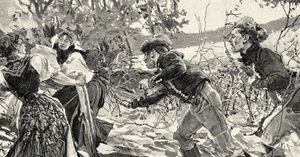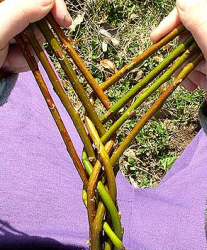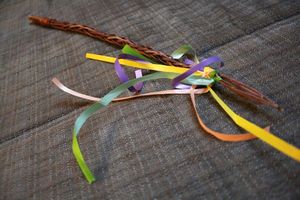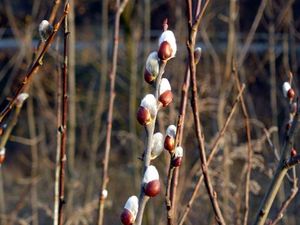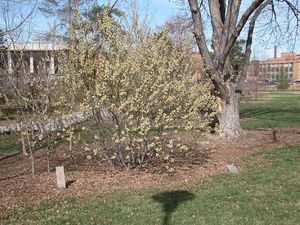Easter and spanking
There are folkloristic spanking traditions connected to the Easter celebrations in several European countries.
In the Czech Republic, Slovakia and Hungary
In the Czech Republic and Slovakia, boys traditionally awake girls on Easter Monday (called Velikonoční pondělí or Pomlázka in Czech) morning by dowsing them with water and spanking them on their buttocks or legs with special decorated "Easter whips" called pomlázka (Slovak: korbáč). The boys usually also recite a special poem or a special Easter carol. The dowsing and whipping is thought to chase away illness and bad spirits, and to bring good luck, wealth and rich harvest for the whole year. Also, the strength from the rods is believed to be passed onto the person whipped. The girls would reward the boys with coins, candy, Easter eggs, a ribbon, or a shot of liquor.
The pomlázkas are made by the boys from freshly cut thin willow switches, typically eight rods per whip. The rods are soaked in water to make them soft and flexible, and then braided into a strong yet flexible whip. Finally, colorful ribbons are knotted on the top end of the pomlázka.
The dousing is either done before or (more often) after the whipping. It may be done by pouring a bucket of water on the girl's head, by grabbing the girl and putting her head under a water pipe or shower, or throwing her in a bath of cold water or into a river. There's a lot of screams, laughter and cheering with these games.
In the afternoon, females can douse males in return with cold water. In some other parts of Slovakia, boys use water or perfume to splash the girls on Monday and then girls whip boys on Tuesday. In Hungary, perfume or perfumed water is used.
This folkloristic tradition is possibly connected to a pre-Christian, pagan fertility rite, that seems originated from similar older customs such as the Ancient Roman Lupercalia. The Easter dowsing and whipping is also said to symbolize the "rousing" from the resting time of Winter to the activity of Spring.
In Czechia, such a switch is called pomlázka meaning "rejuvenator", implying that a female struck by a pomlázka will become younger and prettier.
In Latvia
In Latvia there is a spanking tradition on Palm Sunday (called Pūpol Svētdiena, Pussy Willow Sunday) morning. Children and women are awoken by being spanked with switches of pussy willow or (rarely) birch. This spanking has a fun character and is usually given on the bare bottom after removing all clothes from the spankee's posterior.
It is believed that positive energy from the trees is coming to the person who is spanked. A variation of the tradition is to spank people with the pussy willows not in the bedroom, but in the neighbourhood. In that case, usually young men catch a girl or young woman and order her to bend over for spanking. These public spankings are mostly given on the clothed rear, rarely on the bare buttocks.
In Poland
Dyngus Day or Wet Monday is the name for Easter Monday in Poland. In Polish it is called Śmigus-dyngus or Lany Poniedziałek.
In Poland, traditionally, on this day early in the morning boys awake girls by pouring a bucket of water on their head and striking them about the legs with long thin switches made from willow, birch or decorated tree branches (palmy wielkanocne). This tradition was already in custom in 750 AD, i.e. 250 years before Poland officially adopted Christianity, so it seems to be of pagan origin that was later reinterpreted in a Christian sense.
One theory is that Dyngus originates from the baptism on Easter Monday of Mieszko I (Duke of the Polans, c. 935 - 992) in 966 AD, uniting all of Poland under the banner of Christianity. Dualism and "twins" are featured in Slavic pre-Christian paganism. Dyngus and Śmigus were twin pagan gods; the former representing water and the 'moist' earth (Dyngus from din gus - thin soup or dingen - nature) and the later, representing thunder and lightning (Śmigus from Śmigać or to making a whooshing sound). In this theory, the water tradition is the transformation of the pagan water god into the Christian baptism. The custom of pouring water was an ancient spring rite of cleansing, purification, and fertility. It is alleged that the pagan Poles bickered with Nature/Dyngus by means of pouring water and switching with willows to make themselves pure and worthy of the coming year. Others have suggested that the striking tradition is the transformation of the ritual "slap" of Christian confirmation. However, still others suggest that the Śmigus tradition may also be related to another Polish whipping tradition on Good Friday in which parents woke their children with switches from twigs, whispering the words of a Lent prayer "The Wounds of God" or "God is Wounded" - bozerani.
Politics played an important role in the proceedings, and often the boy would get access to the house only by arrangement with the girl's mother. Throughout the day, girls would find themselves the victims of drenchings and leg-whippings, and a daughter who was not targeted for such activities was generally considered to be beznadziejna (hopeless) in this very coupling-oriented environment.
Most recently, the tradition has changed to become fully water-focused, and the Śmigus part is almost forgotten. It is quite common for girls to attack boys just as fiercely as the boys traditionally attacked the girls, so today Dyngus Day is basically just a water splashing fun fight. With much of Poland's population residing in tall apartment buildings, high balconies are favorite hiding places for young people who gleefully empty full buckets of water onto randomly selected passers-by.
In Sweden
Sweden has a long tradition of the Påskris (Swedish for "Easter-birch"), which nowadays is used only as a decoration in many homes. From the 17th century to the mid-20th century there was a tradition of birching family members as a reminder of the suffering of Jesus Christ. It was usally on Shrove Tuesday and/or Good Friday (called "Long Friday" in Sweden). The members of the housEhold would birch each other, often in the morning. The farmhands/maids/servants birched their masters, and were in turn punished themselves. Parents and children also took turns birching each other — a rare opportunity for children to have punitive power over their parents.
As the years passed, the birching tradition gradually took on the aspect of a game played for fun rather than a painful reminder of the suffering of Christ. By the late 20th centrury, the tradition had greatly declined in popularity. Still, in some households, the first one to wake up gets to whip the other family members with the Easter-birch in a light-hearted manner.
Today the Påskris is used more for display than for birching. It is typically put in a vase and decorated with ribbons, feathers, and Easter eggs.
See also
- More information is available at [ Wikipedia:Easter Monday ]
Links
- Photo that shows the Pomlázka braiding technique
- Pomlázka braiding tutorial (in Czech)
- Pomlázka braiding tutorial drawing
- A nice finished Pomlázka
- An artistic Pomlázka illustration
- A korbáč braiding tutorial (in Slovak)
Chat rooms • What links here • Copyright info • Contact information • Category:Root
